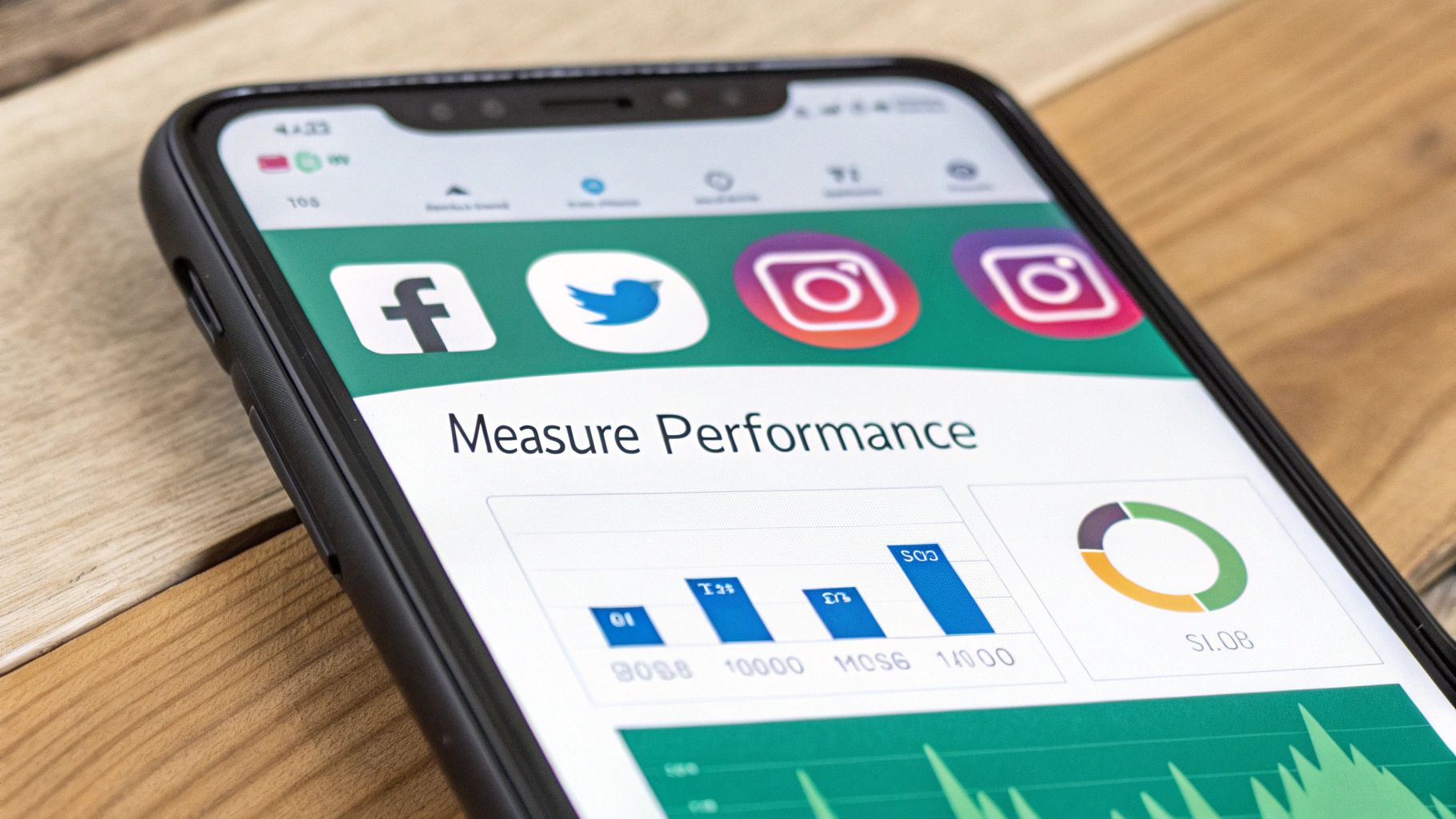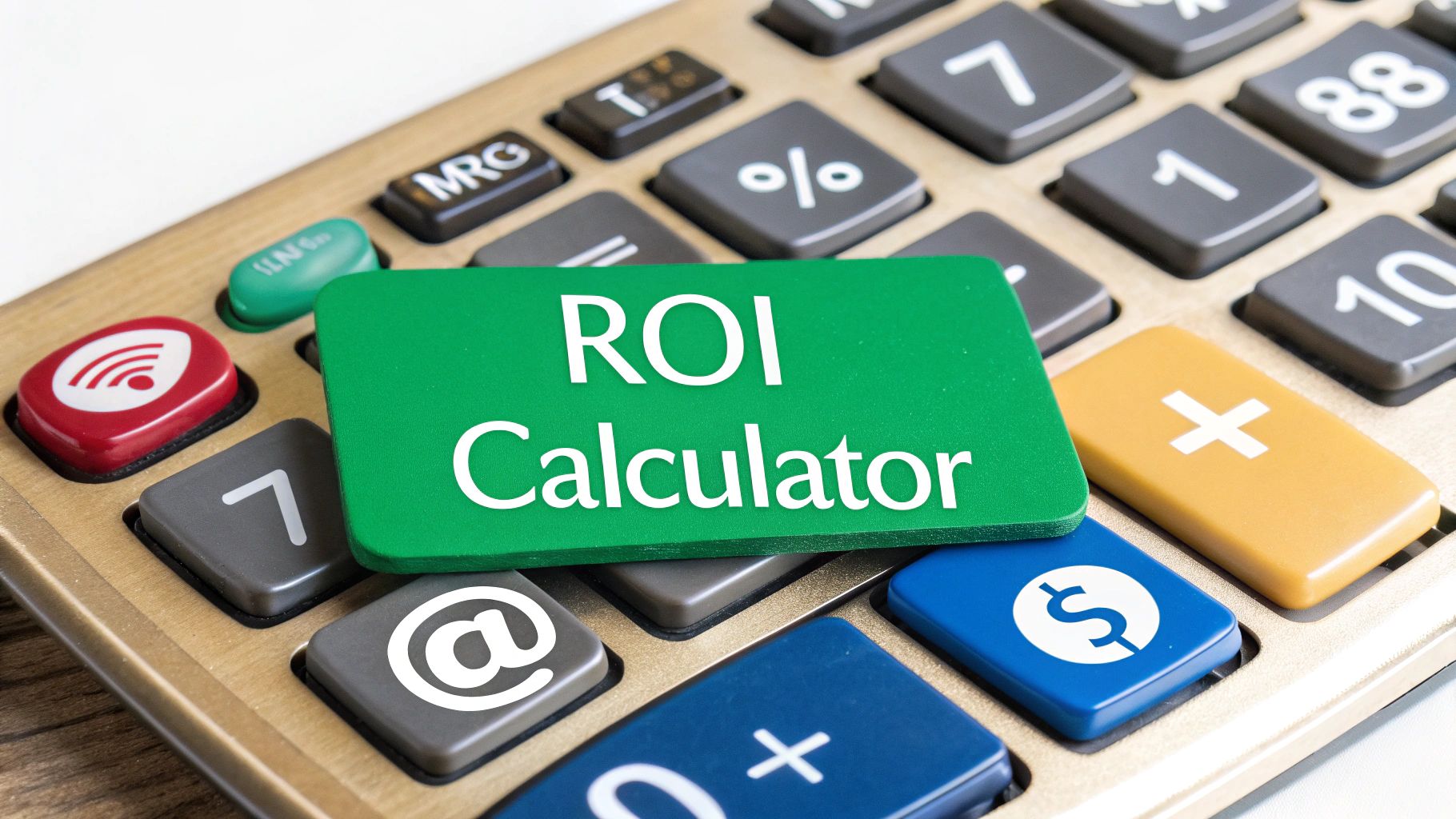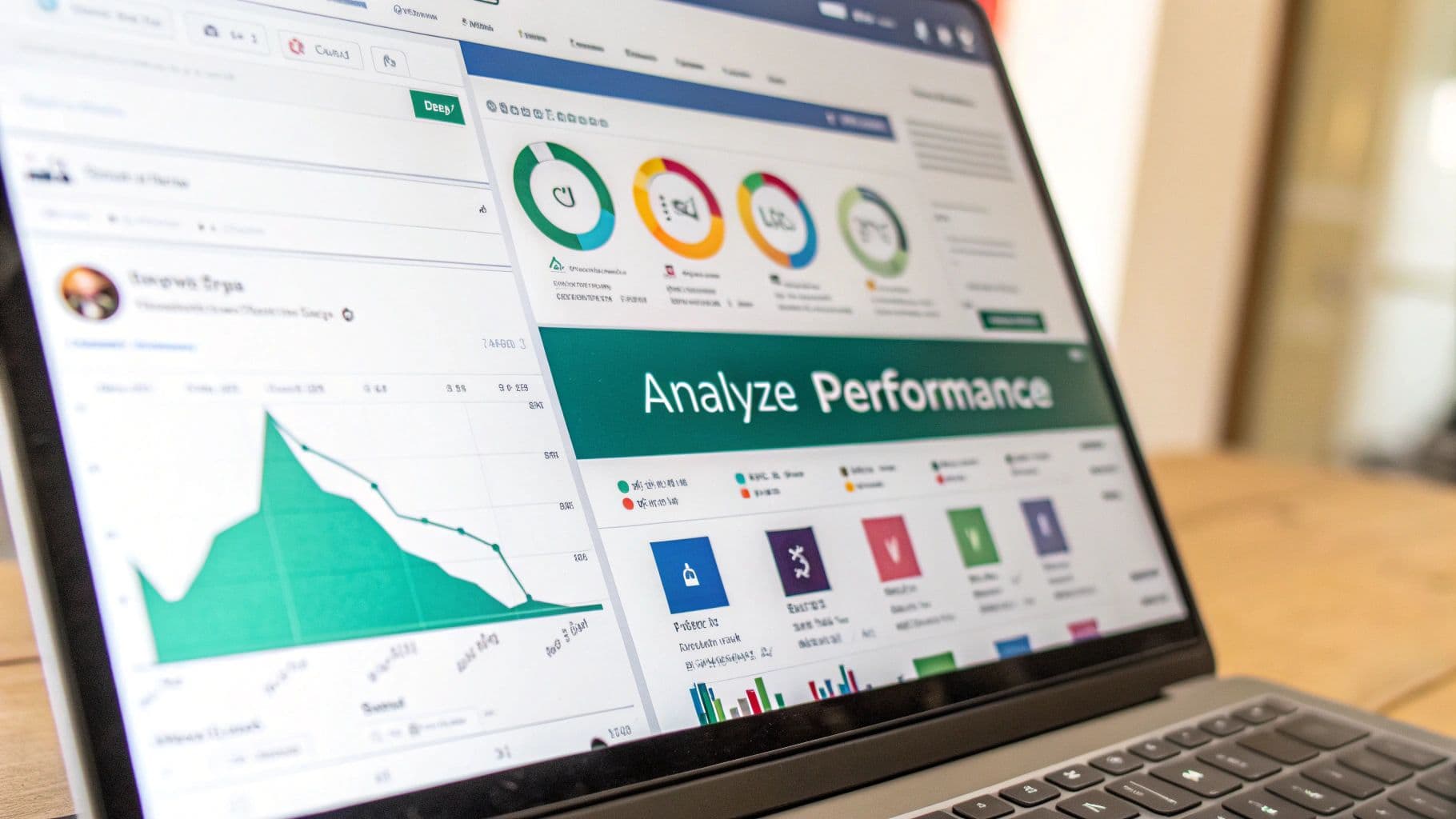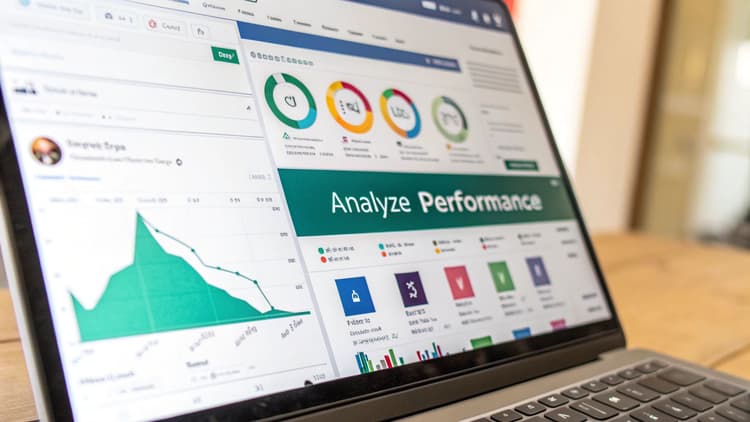Understanding Social Media ROI With Confidence
Defining Your ROI Objectives
Before jumping into calculations, get crystal clear on what you want to achieve. Different goals need different measurements - brand awareness campaigns focus on reach and impressions, while lead generation efforts track conversion rates and cost per lead. The key is matching your metrics to your actual business objectives. Clear goals ensure you measure what truly matters, not just what's easy to track.
Choosing the Right Metrics
Don't get distracted by surface-level metrics like follower counts. Focus instead on numbers that connect directly to your business goals. Think of it like sports - a packed stadium doesn't guarantee a win, just like lots of followers don't automatically mean business success. You need metrics that show real impact. For more insights, check out How to master business.
Implementing Effective Tracking Systems
Strong measurement starts with reliable tracking tools. Popular options like Google Analytics, native social platform analytics, and specialized social media management software provide the data you need. These tools help you monitor performance in real-time, spot what's working, and quickly adjust your approach. Regular tracking builds a clear picture of your campaign's true impact over time.
Your social media ROI calculation shows whether your marketing dollars are working hard enough. The basic formula is straightforward: Social Media ROI = (Net Profit from Social Media / Social Media Investment) × 100. For example, if you earn $10,000 in revenue from social campaigns that cost $2,500, your net profit is $7,500. Plugging those numbers in: (7,500 / 2,500) × 100 = 300%. This means every dollar invested brought back $3 - a strong return. Learn more about ROI calculations at Social Media ROI Calculator. Understanding this core formula helps you confidently assess performance and make smarter decisions about future campaigns.
Navigating ROI Measurement Challenges

Measuring the true impact of social media marketing available several key challenges. To show the real value of your social strategy, you need to understand and tackle these obstacles head-on. Let's explore the main challenges and practical solutions for measuring social media ROI effectively.
Overcoming Attribution Complexity
Attribution remains one of the trickiest aspects of social media measurement. Most customers interact with your brand multiple times across different channels before making a purchase. For example, someone might discover your product on Instagram, research it through Google, and finally buy after getting an email offer. This makes it hard to determine how much credit each touchpoint deserves. The solution? Use a multi-touch attribution model that gives weighted credit to each step in the customer journey.
Addressing Data Fragmentation
Data fragmentation creates another significant hurdle. With social data spread across various platforms and analytics tools, getting a complete picture becomes challenging. Your Facebook analytics might live in one place while your CRM data sits in another. To solve this, build a central dashboard that pulls together data from all your key sources. This gives you a single source of truth for measuring your social media performance.
Dealing With Tracking Limitations
Some valuable aspects of social media marketing are harder to measure with pure numbers. While tracking clicks and sales is straightforward, measuring brand awareness and community impact requires a different approach. The key is combining hard metrics like reach and engagement with qualitative data from social listening and sentiment analysis. This gives you a complete view of how social media affects your brand.
According to recent Sprout Social research, one in two marketers struggle to calculate their social media Return on Ad Spend (ROAS). Tools like Vaizle's Social Media ROI Calculator can help streamline the process. You can get clear insights into your social media ROI by inputting key metrics like social traffic, conversion rates, and average order value.
Maintaining Data Integrity at Scale
As you expand your social reach, keeping your data accurate and consistent becomes more complex. Good data integrity requires clear processes and regular audits of your tracking systems. Make sure you have proper data governance in place and invest in reliable analytics tools. Regular checks help catch any tracking issues early. With clean, reliable data, you can make better decisions about your social media strategy and show clear results to stakeholders.
Harnessing AI for Advanced ROI Analysis

Social media marketers increasingly rely on artificial intelligence to measure campaign performance more effectively. This shift stems from the growing need to calculate ROI faster and with greater precision. The way machine learning analyzes social data has opened up exciting new possibilities for understanding what drives results.
Predictive Modeling for Future Performance
Predictive modeling stands out as a game-changing AI application. By processing historical campaign data, AI can forecast which content will resonate most with audiences. For instance, it can identify posts likely to generate high engagement or pinpoint the demographics most ready to convert. This foresight helps marketers adjust their strategies before issues arise and optimize their spending for better results.
Automated Insight Generation
AI excels at finding patterns in large datasets that humans might miss. Rather than spending hours manually analyzing spreadsheets, marketers can now use AI tools to quickly surface key trends and opportunities. This automation frees up valuable time for creative work and audience engagement while uncovering insights that drive better performance.
The adoption of AI in social media marketing continues to grow, making ROI measurement critical. Tools like the AI ROI Calculator for Social Media Marketing help estimate potential returns by analyzing factors like current spending, engagement increases, conversion growth, and customer value against AI costs. For example, if you input a 10% boost in engagement, 5% higher conversion rates, and $100 customer lifetime value, the calculator projects your expected ROI to guide strategic planning. Learn more at The Social Media Hat. You might also be interested in: Gainsty Reviews.
Balancing AI With Human Expertise
While AI provides powerful analytical capabilities, human judgment remains essential. The most successful brands combine AI's data processing with human creativity and strategic thinking. This means using AI to gather insights while relying on marketers' expertise to interpret results and develop effective campaigns that connect with audiences.
Frameworks for Implementing AI Tools
Adding AI to your workflow requires careful planning. Start by identifying specific challenges you want to solve and key metrics to track. This clarity helps you select tools that match your needs and integrate smoothly with existing systems. Focus on solutions that directly support your goals rather than implementing technology for its own sake.
Real-World Examples of AI-Driven ROI Analysis
Many companies already use AI successfully to improve their social media ROI. Some target ads more precisely using AI, achieving higher conversion rates. Others deploy AI chatbots to enhance customer service and generate qualified leads. These examples show how AI analysis creates tangible benefits by revealing hidden patterns in user behavior and automating routine tasks. This deeper understanding helps teams focus their efforts where they'll have the most impact.
Mastering Conversion Tracking and Valuation
Success in social media marketing requires measuring the real financial impact of your activities, not just counting likes and shares. The key is creating systems that capture both immediate returns and the long-term value generated through social media engagement.
Building a Comprehensive Tracking Framework
A strong tracking system monitors every meaningful interaction between your brand and potential customers. This goes beyond just tracking direct sales to include email signups, content downloads, and other lead-generation activities. For example, when someone first discovers your brand through a social media ad, visits your website multiple times, and eventually makes a purchase, your tracking should log each step of that journey.
Assigning Monetary Value to Social Interactions
After establishing solid tracking, the next challenge is determining the financial value of different types of engagement. Direct sales have a clear value based on purchase price. But other interactions, like newsletter signups or whitepaper downloads, need careful analysis. For instance, when valuing a new lead from social media, consider their potential long-term value as a customer.
THAT Agency's free social media ROI calculator helps track and value these conversions. Their spreadsheet tool works with Google Analytics data to analyze purchases, form submissions, and resource downloads. You can input values based on your historical data or estimated cost per lead, then break down ROI by platform.
Implementing Advanced Attribution Models
Attribution models help you understand how different touchpoints contribute to conversions. Simple last-click models give all credit to the final interaction before purchase. However, multi-touch attribution provides better insights by recognizing how earlier social media engagements influence the buying decision.
Demonstrating the Full Value of Your Social Media Investment
With robust tracking and accurate conversion values in place, you can clearly show stakeholders how social media drives business results. The data helps optimize your campaigns and guides smart resource allocation. Regular reporting on these metrics builds confidence in your social media strategy and helps secure ongoing support. Most importantly, it gives you concrete numbers to demonstrate the return on your social media spending.
Communicating ROI to Drive Stakeholder Buy-In
Getting stakeholder support for social media marketing requires more than just numbers - you need to tell a compelling story with your ROI data. The key is explaining complex metrics in a way that clearly shows how social media efforts directly impact business goals.
Crafting a Compelling ROI Narrative
Start by connecting your social media results to specific business objectives. For example, if your goal was lead generation, highlight exactly how many qualified leads came from social channels and what those leads are worth. This direct link between social media activities and concrete business outcomes makes your case much stronger.
Using Visual Data to Make Your Point
Charts and graphs can communicate trends and results much more effectively than raw numbers. For instance, a simple line graph showing the steady growth in website visits from social media tells a clearer story than spreadsheet data. Pick visuals that instantly demonstrate the positive impact of your campaigns.
Building Clear, Focused Presentations
Keep stakeholder presentations direct and focused on what matters most. Begin with your objectives, share the key metrics that show progress, and end with clear takeaways about the value delivered. Use visuals strategically to emphasize your most important data points. You might find Gainsty for agencies helpful for reporting.
Connecting ROI to Business Goals
Your ROI reporting should demonstrate how social media supports broader company objectives. Go beyond surface-level metrics like followers to show real business impact - for example, how social engagement drives sales or how brand awareness campaigns strengthen customer relationships over time.
Regular ROI tracking helps prove the worth of social media investments. Track metrics like monthly new clients, social media staff costs, and client lifetime value to build a complete picture. Tools like Hootsuite, Sprout Social, and Google Analytics provide detailed data to measure and visualize results. Find additional statistics at Social Sellinator.
Maintaining Trust Through Transparency
Be completely open about your measurement approach, including which metrics you track and any data limitations. This builds credibility with stakeholders. Present balanced results rather than cherry-picking only the best stats. Showing both successes and areas for improvement demonstrates your commitment to honest reporting.
Creating a Data-Focused Culture
Share social media insights across teams to help everyone understand its impact. When the whole organization sees how social media drives real results, it becomes easier to get support for new initiatives. Make data-driven decision-making a core part of your company's approach to social media strategy.
Building a Future-Proof ROI Strategy

Social media changes quickly, so your ROI measurement needs to adapt just as fast. Success today looks different than it did even a year ago. By understanding key trends and shifts in social platforms, you can create a measurement system that works both now and down the road.
Adapting to Evolving Privacy Regulations
User privacy has become a central focus across social media. Recent regulations limit how brands can track and target audiences. For example, many platforms now restrict third-party data access, making first-party data more valuable than ever. The key is building direct relationships with your followers and being transparent about data collection.
Navigating Platform and Technology Changes
New social networks pop up regularly while existing ones roll out major updates. Your measurement approach needs enough flexibility to handle these shifts. This could mean testing different analytics tools or adjusting which metrics matter most. For instance, when TikTok sparked the short video trend, many brands had to rethink how they track content performance.
Developing Flexible Measurement Frameworks
Rather than using rigid metrics, create a framework that can grow and change. Start with core business goals like sales and brand awareness, then add platform-specific measures underneath. This lets you compare results across channels while still capturing what makes each platform unique.
Staying Ahead of Industry Shifts
The social media field moves fast. To keep up, make learning a regular habit. Read industry blogs, join professional groups, and test emerging trends early. Understanding shifts like the growth of social commerce helps you spot new ways to measure success.
Protecting Your Measurement Investments
The tools you use to track ROI are valuable assets. Choose solutions that play well with others and let you export your data easily. This prevents getting locked into one system and helps preserve your historical data if you need to switch tools later.
Keep an eye on new technologies that could impact social media marketing. Augmented reality (AR) filters and live shopping are just the start. Testing these features early helps you understand their potential impact on ROI measurement.
Ready to take your Instagram growth to the next level organically? Gainsty, an AI-powered social assistant, helps you gain real followers and boost engagement without bots or fake accounts. We tailor strategies to your specific industry and niche, providing expert support and detailed analytics. Get started with Gainsty today!















